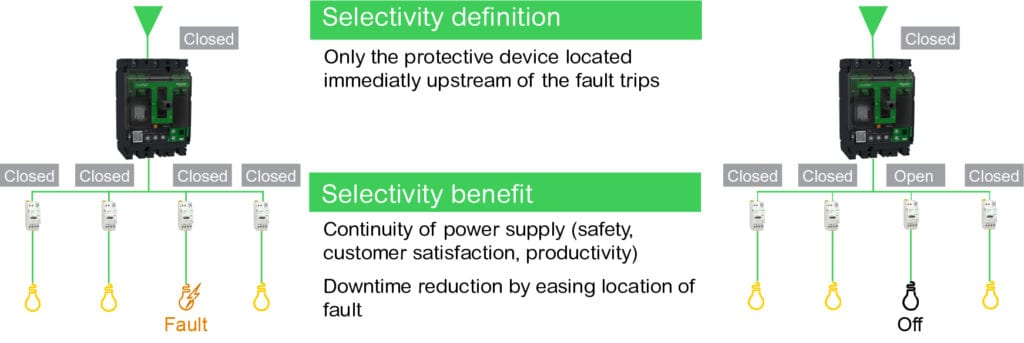No matter the facility, unplanned downtime can be extremely costly. In this post we’ll look at some of the impacts of downtime, the parts that power availability and reliability play in this equation, and the five ways that digital products, software, and services working together can help.
The real cost of downtime depends largely on the type of organization. For example, a Ponemon study reported that the average cost of a data center outage is over $740k. In healthcare, the average estimated downtime cost per minute is $8,662, an outage lasting 8 hours could cost $4.1M and this doesn’t even include the critical risks to human life. U.S. commercial and industrial businesses reported that 40% had experienced a power outage costing more than $50,000 during the last year, with 2% reporting losses over $2 million.
Common causes of power outages in modern facilities
So what’s the cause of these outages? Some are the result of major power grid outages. In fact, extreme weather events have been increasing in recent years, with sixteen weather disasters with losses in the billions of dollars experienced in the U.S. in 2017. Another major contributor is a facility’s own internal power infrastructure. Electrical networks are becoming more complex, with decentralized power sources and more power electronic devices causing more power quality ‘pollution’. These conditions can impact the reliability of increasing amounts of digitized, power-sensitive equipment. If power distribution is not designed, protected, monitored, and maintained properly, there can be hidden risks to the power availability you depend on.
What’s the difference between power availability and reliability?
Let us clarify a couple of definitions that are often confused. Understanding these terms can help us better understand best steps forward.
- Power availability. The IEC defines availability as the “ability to be in a state to perform as required”. Put simply, this is uptime. Or in data center speak, the ‘number of 9s’. For example, 99.999% uptime is five 9s, which equates to about 5 minutes of downtime per year. Uptime will be affected by the reliability of a facility’s infrastructure, but also by how fast the facility can recover from an outage.
- Power reliability. The IEC defines reliability as “the ability to perform as required, without failure, for a given time interval, under given conditions.” In other words, to ensure you have the maximum power uptime in your facility, you need your power infrastructure to operate reliably without any problems for the greatest duration possible, and that includes every component in the system. There’s a lot of things that can affect how reliably your electrical system runs. This includes how well the system is designed, its operating and environmental conditions, how well equipment and conditions are being monitored, and how well equipment is maintained.
5 ways to improve power availability
The power availability and reliability of a distribution system encompasses its entire lifecycle, from design to operations. Consider these five approaches:
1. Pre-engineered reference designs
A pre-engineered medium and/or low voltage electrical distribution system will be based on a reference design that has been validated for the specific application.
A design should include the core power system design, as well as the connected, digital layer of intelligence used for power management. To further enhance resilience the design can include backup power and power conditioning (e.g. generators, uninterruptible power supplies (UPS), automatic transfer switches (ATS), harmonic filtering). It should also comply with local regulations and international standards, and be optimized for safety to help avoid injury to people and damage to equipment.
A pre-engineered reference design will also significantly streamline the design-build process, reducing both the overall risk and cost of implementing and operating the system. Specialized electrical distribution design software optimizes every aspect of the system for its specified application, taking into account all expected operational and environmental conditions, today and tomorrow. This will help future-proof the facility.
2. Smart circuit breakers
The newest circuit breaker technology protects people and equipment, while at the same time maintaining the operations of a facility. If a fault occurs at any point in an electrical distribution circuit, you don’t want that fault to affect the power availability for the entire facility. Selective coordination is used by circuit breakers to rapidly isolate the problem section, tripping only the circuit breaker directly upstream of the problem section, without depriving the rest of the network of power.

Electrical distribution design enables you to optimize your installation design, selecting sizes and combinations of circuit breakers to provide ‘total’ selective coordination between all stages of the electrical distribution network.
The best circuit breakers are easy to maintain, withdrawable and plug-in features makes them easier to manage. Smart circuit breakers also offer embedded metering capabilities to support connected power management and predictive maintenance.
3. Power management system
Throughout your power distribution system, there can be risks to reliability that are hidden and go unnoticed. A fully digitized electrical system can better withstand power disturbances and is resilient to downtime. A power management system takes advantage of data from connected devices, acting like a microscope on your electrical system, continuously monitoring its performance and the assets connected to it. If any unexpected condition is detected, an alarm notifies personnel wherever they are so that they can immediately locate the issue and take action to prevent a critical situation.
A connected power network includes intelligent, connected advanced power meters that quickly reveal power quality issues – such as high harmonics or voltage sags – or other types of faults, while diagnostic tools help facility team determine root causes before they can cause an outage.
A digitally-connected power management solution should also include wireless thermal sensors, for early detection of abnormal temperature rises on conductors and connection points. This will help reduce the risk of a fire or failure (and associated downtime), while avoiding the time and cost of annual infrared (IR) testing. Another recent innovation is the ability to monitor circuit breaker health and aging, with advanced analytics that enable more proactive maintenance, preventing performance issues, and extending breaker life. These capabilities help ensure that a clean, stable power is always available 24/7, while reducing operational costs.
4. Expert services for predictive maintenance
Cloud-based power management applications act as a portal to remote expert services. If your organization has limited onsite technical resources or expertise, these ‘digital services’ can help you reduce the complexity and time needed to manage your power distribution systems, while improving power quality, reliability, and availability.
Expert advisors will monitor your operation 24/7, delivering condition-based insights about your electrical system health and asset performance. These insights enable a more predictive maintenance approach, resulting in fewer operational failures and a downtime reduction of 30 to 50%. Advisory services, including Schneider Electric EcoXpert partners, can also help you evolve your system over its life cycle.
5. Fault localization and power recovery
Despite taking all these steps to prevent downtime, there is always the chance of unplanned downtime. If a fault occurs, you need to minimize its duration and impact. Having the right products and software will help ensure a rapid recovery. Some of the newest tools will the on-site facility team automatically correlate system-wide data and reveal the propagation of a disturbance to isolate the source. In addition, smart protection relays, trip units, and accessories (e.g. auxiliary contacts, etc.) will help more quickly localize a fault, identifying the tripped circuit-breaker and its associated circuit. A smartphone app can then be used find the root cause of the incident, and have access to step-by-step guidance to help quickly restore power.
In the more complex, more power-sensitive ‘New Electric World’, businesses face the risk of more unplanned downtime, highly inefficient electrical operations, and more frequent equipment failures. These can all lead to higher OPEX spending and, in some cases, major financial losses. For these reasons, more focus must now be placed on using the right technologies and services to help ensure innovative power solutions.
Visit our solutions page to learn more about power availability and reliability.



